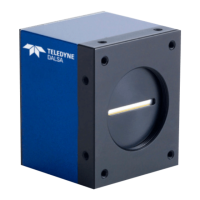46 Spyder3 SG-34 GigE Vision Color Manual
03-032-20124-00 Teledyne DALSA
Prepare for Calibration
For best results, the camera should be setup for calibration with similar conditions as to those in which it
will be used. For example, data mode, exposure times and line rates, scan direction, etc.
For example, set the color gain for the current color using the Color Gain command.
Step 1: White Balance Calibration
1. Remove the lens cap and prepare a white, uniform target.
2. Adjust the line rate so that the average output is about 80% of the full output by: adjusting the
lighting, if you are using an internal exposure mode. Or, adjust the line rate, if you are using the
Smart Exsync mode.
3. White balance calibrates individual colour gain settings so that the outputs are equal between the
colors. Calibrate the white balance using the command s Calibrate White Balance Target and
Calibrate White Balance, where the target value (always counted as 12-bit) is 1024 to 4055 DN. For
example, if you want to set the target to 255 x 80% = 204 DN in 8-bit mode, then the target value is
(204/ 255) x 4096 = 3277 DN in 8-bit mode. Therefore, you can set the target to 3300 DN.
Calibration results from the Calibrate White Balance command:
Success
Clipped to min > Color gain set minium, failure to reach target
Clipped to max > Color gain set maximum, failure to reach target
Timeout > FPGA did not return new end of line statistics or video line
Step 3: FPN Calibration
Note that you do not need to turn off the FPN and PRNU coefficients before calibrating, the camera will
do this automatically.
1. Stop all light from entering the camera. The best way to do this is to put on lens cap.
2. Calibrate FPN using the FPN Calibrate command.
3. Use the Read FFC Calibration Result parameter to determine if your calibration was a success or
not.
4. To save the calibrated FPN coefficients to the FFC coefficient set shown, use the Set FPN Save
parameter.
Step 4: PRNU Calibration: White Calibration
Performs PRNU calibration to user entered value and eliminates the difference in responsivity between
the most and least sensitive pixel creating a uniform response to light. Using this command, you must
provide a calibration target.
Executing these algorithms causes the Background Subtract (DN) value to be set to 0 (no background
subtraction) and the Digital Gain (DN) value to 4096 (unity digital gain). The pixel coefficients are
disabled (Pixel Set Load 0) during the algorithm execution but returned to the state they were prior to
command execution.
1. Remove the lens cap and prepare a white, uniform target.
2. Adjust the line rate so that the average output is about 80% of the full output by: adjusting the
lighting, if you are using an internal exposure mode. Or, adjust the line rate, if you are using the
Smart Exsync mode.
3. Set the PRNU target value using the Target to Calibrate PRNU command. The target value (always
counted as 12-bit) and is 1024 to 4055 DN. For example, if you want to set the target to 255 x 80% =

